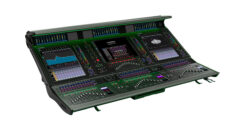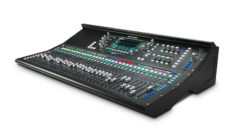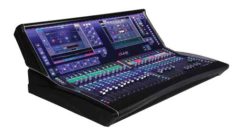
Technology Showcase: HOW FOH Mixers
Jan 1, 2009 12:00 PM,
By Bennett Liles
Options abound for every type of worship service.

Roland M-400
Selecting the best front-of-house mixer for a house of worship is a process that has to take the congregation and worship style of the church into consideration. Traditional services with only the singing congregation, the church organ, and the choir may not need a sophisticated mixing system to allow all this to be heard in the sanctuary — particularly if no recording is done. Add live bands, guest performers, and dramatic productions with live music, and the mixing requirements grow exponentially. A church is a unique venue with a lot of audience participation and volunteer technical talent that combines to present one of the most challenging environments for top-quality sound in the house, online, on-air, and in recording. In many churches, which were not originally designed for live music and reinforced sound, there are also serious acoustic challenges. The mixer is the central core of the system and serves as ground zero for the most direct interaction between people, machinery, and software. Therefore, the selection process requires a careful evaluation of where the church is in its progression and where it intends to go.
Analog or digital, four or eight aux buses, mix-minus feeds, and open loudspeaker or in-ear monitoring? These are just a few of the questions that will float through the process when the front-of-house mixing system begins its journey from need to concept to reality. Many of today’s churches are professional-level performance venues with live music groups performing one after another with a bare minute or two between them. In such cases, digital mixers offer the best solution with saved and instantly recalled setups. Snakes and stage boxes have morphed into one system with the mixer, and they communicate digitally on twisted-pair copper or fiber-optic lines with remote control over onstage mic preamps and recallable electronic patching. The systems included here offer some or all of these features and more to meet the increasingly sophisticated needs of modern worship events.

Allen & Heath iLive-144
The iLive system was developed by Allen & Heath specifically for live-sound applications, and a number of these systems have found homes in large houses of worship. The system is built around the iDR10 stage rack with 10 slots for 8-channel audio interface cards. The iDR-64 DSP module processes 64 channels into 32 mixes. These can be assigned as aux outs, matrix outs, and main outs. The iDR-64 can be controlled with a range of Allen & Heath hardware units, mixer control surfaces, and a PC. The analog look and feel is maintained in the iLive-80, iLive-112, iLive-144, and the iLive-176 with motorized faders grouped into three sections. The LCD display above each input channel strip provides electronic labeling and color-coding capability.
One of the best arguments that analog consoles have a prominent role to play in front-of-house mixing for church sanctuaries is the Spectra series from APB-DynaSonics. It offers the power of VCA control on inputs and outputs. For monitor sends and mix-minus feeds, there are 10 aux banks. The first four are switchable between pre/post fader and pre-EQ, while the rest are operable in mono or stereo pairs. The 100mm master fader control of all auxiliary outputs plus solo, mute, polarity reverse, pre/post matrix send, and sophisticated EQ options make this board an excellent choice as either a FOH or monitor mixer. Dual power supplies add reliability for live sound.
Technology Showcase: HOW FOH Mixers
Jan 1, 2009 12:00 PM,
By Bennett Liles
Options abound for every type of worship service.

DiGiCo D1 Live 40
Designed to emulate the audio character, tools, and features of the popular Cadac J-Type analog mixer, the new S-Digital console adds the latest field-programmable gate arrays and its proprietary High-speed Digital (HSD) communication system to minimize any latency in audio and control. This connects the outboard input and the output racks on either coax or fiber links. Multiple listen systems are featured to accommodate any multi-operator setup, and each hot-swappable module has embedded control that keeps operating even if the Sound Automation Manager goes offline. The input channels are equipped with bar-graph meters, and the rotary knobs are lit to display their settings in a darkened environment. The power supplies are rackmounted, and they can function in a dual-redundancy mode for added reliability.

Euphonix System 5-B
For houses of worship that have limited space for a front-of-house mixer, the DiGiCo D1 Live 40 offers the capabilities needed for the live music and dramatic performances so prevalent today, but in a very compact frame. With full input EQ, dynamics processing, onboard effects, a 38×8 matrix, and 16 VCA control groups, the D1 Live 40 uses its local DigiRack that can be configured with 40 line/mic inputs and 24 line outs. The system can record directly to a multitrack hard-disk recorder and store the entire show setup on a USB key for the ultimate in setup portability from one D1 or D5 Live to another. Three interactive touchscreens bring all the setup and configuration parameters to the operator, and each of these can show eight input channels at a time with a combination of LCD buttons and controls.
The Venue system from Digidesign features a modular configuration that can be customized to the specific size and complexity requirements of the church sanctuary or activity building where it’s installed. The basic components consist of the D-Show mixing console, the FOH rack, the stage rack (with remote-controlled preamps), and the multichannel digital snake. The system can be expanded to include up to 96 mic inputs, 27 buses, eight mono matrices, and eight stereo matrices. These can be controlled remotely by the artists using the Digidesign Personal Q monitoring system. Dual-redundant power supplies provide reliability required for live sound. The heart of the system is the FOH rack with eight analog inputs and outputs, which is expandable to 16; analog and digital two-track connections; intercom circuits; and outputs for near-field loudspeaker monitoring. The D-Show mix engine has powerful DSP cards providing 48-bit pathways throughout the system.
Technology Showcase: HOW FOH Mixers
Jan 1, 2009 12:00 PM,
By Bennett Liles
Options abound for every type of worship service.

Peavey S-32
EAW has accomplished the analog feel in its UMX.96 with its expandable 56×48 analog I/O, open architecture, 48 Penny+Giles touch-sensitive faders, Touch & Spin mix control, internal hard drive, and 16 VCA groups. Each 8-channel group has an associated scribble strip that displays the custom channel name and virtual potentiometer (V-Pot) information using black text on a bright-white background for clarity in low-light conditions. The UMX.96 also features 48 digitally controlled mic preamps, 24 user-assignable aux groups, and the 16×8 Matrix Plus with individually selectable input sources. Each input channel offers a balanced TRS send/return and a TRS direct out, gate, compressor, four-band EQ, and dedicated HPF and LPF. There are also eight stereo line inputs that feed a stereo compressor and EQ.
For large churches with live sound, Internet streaming, and multiple monitor feeds, the digital Euphonix System 5-B presents a mixing system that carries customization to the maximum degree. There are five different modules to choose from, and the System 5-B provides the operator with metering on TFT displays along with source IDs, channels, groups, auxes, and gain reduction. In addition, there is an LED-level meter on each input strip beside the 100mm moving fader. Twin source designation displays show the Swap function that allows an individual or global swap to a second layer. Each of the faders on the CM408T eight-fader module has eight knobs and knob-function switches. The eMix application integrates with System 5-B to provide setup, file management, and the PatchNet patchbay application.
For midsize to large church sanctuaries hosting live music events, the Harrison Consoles Trion offers its resource-sharing capability to link a FOH and monitor mixer via fiber with the Harrison digital engine. The integrated, high-resolution TFT screens above each eight-fader group simultaneously show a graphical representation of EQ, dynamics, input channel source, bus routing, panning, aux sends, input meter, and the PreView waveform display. The PreView is located on each input channel and provides a 20-second waveform view of any audio source, including the history and preview of the signal as it passes through the channel. If the Digital Tools package is added, there are 32 digital bus limiters with look-ahead and a 20-second loop recorder. For controlling Harrison consoles and other devices, Ikis is a dedicated, dual-processor, custom-configured, PC-based control and automation platform that provides graphically rich information and control screens.
With 512 DSP channels, 144 summing buses, audio follow video, external control of mic amp levels, and simultaneous stereo and multichannel mixes, the mc266 from Lawo is actually an entire sound system that consists of three parts. The mixing console surface with integrated control system is the central element. This is joined with the DSP and routing matrix that is known as the “HD core.” This works with the Digital and Line Level Interface System (DALLIS) I/O interfaces. The control system and HD core communicate over an Ethernet link and an ATM link, both with redundant design. The DALLIS stage boxes are linked by multimode optical fiber for distances up to more than 1 mile, but this can be stretched to nearly 5 miles. The dynamic automation system facilitates the comprehensive timecode-based backup of all signal-processing parameters, and stored system snapshots can be instantly recalled. Using the remote MNOPL protocol, the mc266 communicates with system components for a full range of control options including crosspoints and parameters in the matrix and in the console.
Technology Showcase: HOW FOH Mixers
Jan 1, 2009 12:00 PM,
By Bennett Liles
Options abound for every type of worship service.

Yamaha LS-9
The TT24 portable 24-bit/96kHz digital mixer from Mackie fits the bill for FOH applications in small to midsize churches, and it is particularly well-suited for the growing number of portable churches that have to set up and tear down every Sunday in venues such as high-school gyms and bowling alleys. The unit provides 24 mic/line inputs, each with four-band EQ, compressor, gate, high-pass filter, and polarity reverse switches. In addition, there are line inputs that can be stereo-linked, and the configuration of all these sources can be stored into as many as 99 recallable setups with filtering. The QuickMix section has a 5.5in. LCD touchscreen, 12 push-button rotary encoders, and QuickMix buttons. The TT-24 also provides 12 aux sends with four-band parametric EQ, dual kill filters, and a compressor/limiter.
The Peavey Sanctuary Series is one of the few lines of AV gear developed from the ground up expressly for the house-of-worship environment. At the top of the Sanctuary Series mixers is the S-32 with 28 XLR mic and 1/4in. line inputs, eight automix channels with compressors, two stereo line inputs with three input selections, track selections, and Monitor Blend control for split accompaniment tracks. Monitor Blend can send a mix of left and right program to monitor loudspeakers. The input channels can be sent to three subgroups: choir, solo, and music. Channels 25 to 32 have an additional subgroup that engages the auto-mix function. There are also eight programmable mute groups; high, low, and mid EQ; and direct outputs on all input channels for multitrack recording feeds. The digital effects processing section provides an entire library of effects, and the power DSP allows programming of EQ, crossovers, compression, limiting, and delays.
The M-400 V-Mixer from Roland is integrated with its digital snake, and the system is based on Roland Ethernet Audio Communication (REAC) Cat-5e-based protocol carrying 48 channels of digital audio from the stage to the mixer. The control surface features 25mm×100mm motorized, touch-sensitive faders and an 800×480 color screen that is operated by function buttons just below it. For carrying sound signals for distances more than 1 mile, the S-Opt optical converter can interface with a fiber link. Using the REAC split port on the M-400, a direct Cat-5e connection can be made to a gigabit PC port while running Cakewalk’s Sonar software for multitrack recording.
For sanctuary mixing where space is at a premium, the Soundcraft Vi4 packs 48 inputs on 24 faders and 27 output buses into a desk less than 5ft. wide. Pairs of mono inputs can be linked for stereo operation while 24 insert send/return pairs can be configured and assigned to any of the 48 inputs or 27 output channels. All 48 input channels have direct outputs for multitrack recording or monitor board sends, and connection between the local rack and stage box is made through Cat-5 or Cat-7 twisted pair — saving hundreds of pounds of copper snake. There is also a fiber-optic interface available as an option. With Cat-7, the distance on this connection can extend up to 130 meters. There are controls for four mute groups and 16 VCA groups. The Vi4 features the same Vistonics II interface used on the larger Vi6, and this provides 16 real knobs and switches along with a touchpanel. Each Vistonics II controls eight input channels.
Technology Showcase: HOW FOH Mixers
Jan 1, 2009 12:00 PM,
By Bennett Liles
Options abound for every type of worship service.
Like some of its predecessors, the Studer Vista 8 features the Vistonics operating concept that integrates rotary control and buttons within the TFT display to keep the operator’s line of sight for controls close to that for visual monitoring of system parameters. Arranged above and below the screen are fader, mute, and on/off buttons for easy reach and limited eye scanning. The operating desk consists of a control bay and between two and seven channel bays — each of which incorporates 10 100mm faders, the Vistonics graphical operating unit, additional assignable rotary encoders, and more buttons and controls. Each channel has a high-resolution dual-color bar-graph meter with additional gain reduction display for the compressor/limiter and expander/gate. In the Global View area, there are color-coded buttons to select the functions of the rotary controls.
For smaller church sanctuaries and activity centers with live music events, the Tascam DM-4800 is a contender with its extensive remix capability and software applications. The control desk offers 48 channels and 16 returns for a total of 64 inputs. The DM-4800 also has 24 buses, 12 aux sends, 24 channels of TDIF, and eight channels of ADAT built-in. Multiple track recordings of church services and other events can be recorded, and the board can be quickly reconfigured for mixdown. The mixer can expand with cascading capability for two DM-4800s as needs grow. There are also per-channel LED ring encoders for pan, aux sends, and EQ along with four expansion card slots for FireWire, ADAT, AES/EBU, analog, TDIF, and surround monitoring cards.
The Yamaha LS-9 is available in either a 16- or 32-input version with recallable head amplifiers, mini-YGDAI expansion slots for interfacing with digital audio distribution systems, four stereo input channels, digital patching, 16 mix buses, eight matrix buses, and one stereo and mono bus. The LS-9 also features built-in sound recording with a USB interface and full console scene store and recall. The setup can be expanded to 64 inputs with additional external preamps and mini-YGDAI interface cards. Illuminated switches, 100mm motorized faders, and LED-level meters are on every input channel. More detailed system settings are located through the display access keys, and one touch of the home key will instantly return the operator to the main operating mode.
MORE INFORMATION
Allen & Heath
www.allen-heath.com
APB-DynaSonics
www.apb-dynasonics.com
Cadac
www.cadac-sound.com
DiGiCo
www.digico.org
Digidesign
www.digidesign.com
EAW
www.eaw.com
Euphonix
www.euphonix.com
Harrison Consoles
www.harrisonconsoles.com
Lawo
www.lawo.de
Mackie
www.mackie.com
Peavey
www.peavey.com
Roland
www.rssamerica.com
Soundcraft
www.soundcraft.com
Studer
www.studer.ch
Tascam
www.tascam.com
Yamaha
www.yamaha.com









